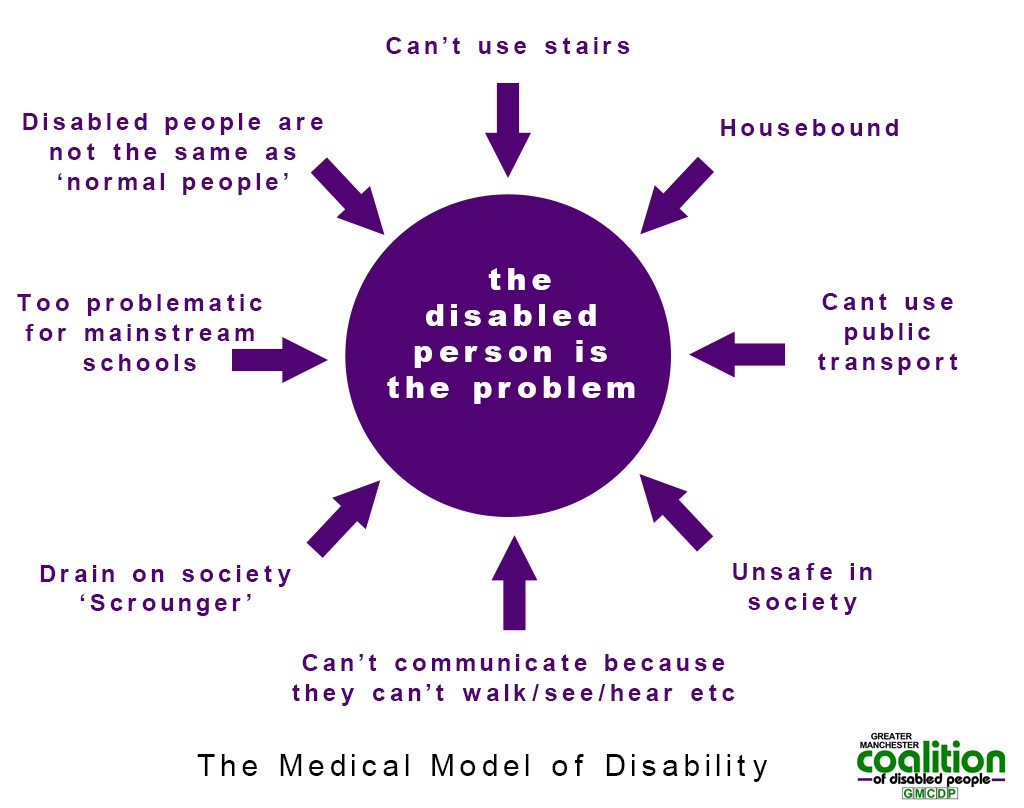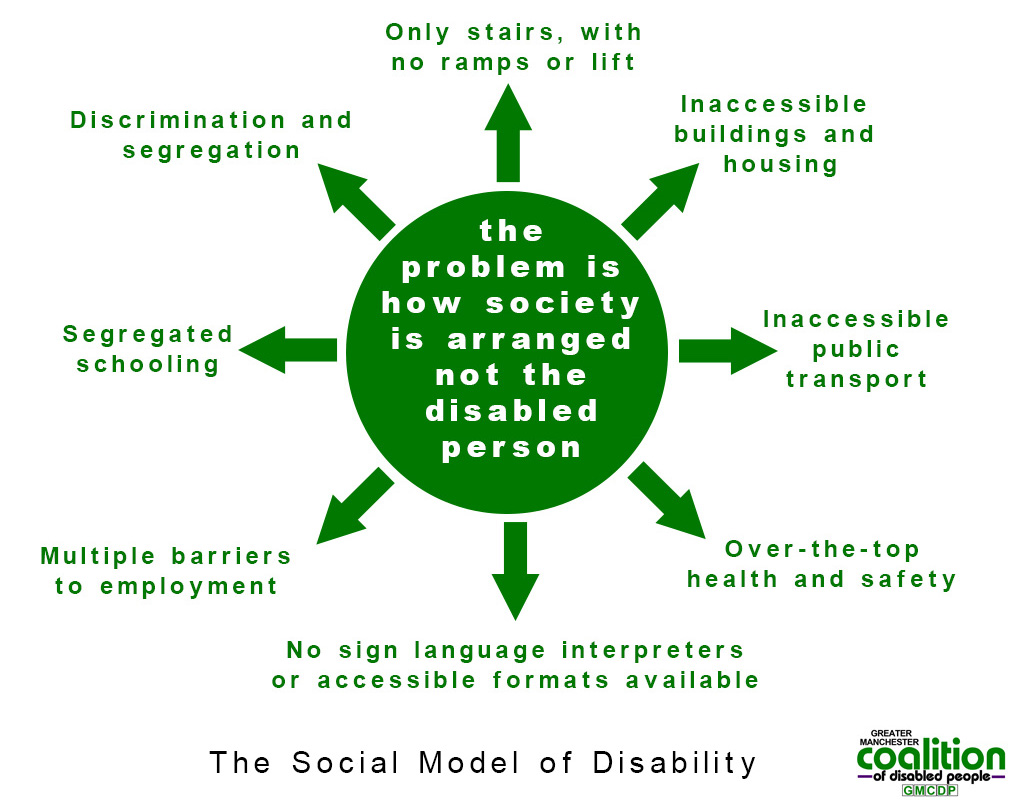In this post, a thought experiment about disability. It invites children to imagine a world in which a few people can fly, but not them; then to imagine a world in which most people can fly, and they are in a small, non-flying minority. In the first world, they are not disabled. In the second, they are – even though nothing about them has changed. I have had some deeply thoughtful enquiries with primary children using this idea.
Medical and Social Models of Disability
The flying thought experiment is a great way of provoking thinking about perceptions and experiences of disability, and in particular the social model of disability, a term coined by Mike Oliver who died in March of this year. In this view of disability, rather than seeing the body through the medical model, of a disabled person as a machine that needs to be fixed, it sees society – how it physically and socially structured – as the main contributory factor to disability.
Images courtesy of Greater Manchester Coalition of Disabled People
It’s based on a facebook post by Vivian Cox, with whose permission I have written this issue. You can read the full text of her original post below. I ran this session with Year 4s and it led to a very thoughtful, insightful enquiry. Of course, any enquiry you have needs to be sensitive to any children with disabilities in the group, and avoid putting a burden on them to testify for all disabled people – so check in with them and parents in advance.
—-
Enquiry Plan
Because this is quite an involved thought experiment, the enquiry is less open in structure than it might normally be. But there is still a lot of room for creative, critical and empathetic thinking. If you need to do a warm-up, do one that is unconnected with the theme: maybe something about consequences such as, “What Would Happen Then…” (see this extract from Thinking Moves). But leave plenty of time to work through these steps:
Step 1 – SomeFly
Imagine a world just like this one, but in which a small minority of people are born with wings and can fly. You are just like you are now, and are not part of the small minority of flyers. What would change about the world if a small minority of people could fly?
Step 2 – MostFly
Now imagine that most people can fly can. You are just like you are now, and are part of the small minority that cannot fly. What would change about the world if most people could fly?
Step 3
What would life be like for you in the SomeFly world? What would it be like in the MostFly world? (This can work well if you allow a moment for silent reflection to really engage the imagination.)
Step 4
Are you disabled in SomeFly? What about in MostFly?
Step 5
What would have to change about MostFly to stop it disabling people?
Step 6
How is our world like MostFly?
Step 7
How would our world need to change to allow stop it disabling people?
Of course, by focusing on an analogy with wheelchair use, it risks drawing attention to the narrow, stereotyped view of disability. But you can talk about the wider range of disabilities including hidden disabilities that people may have, and that also need adjustments.
—
Vivian’s Original Post
Imagine an alternate reality, just like this one, where you and everyone you love exists. The difference is that a tiny portion of the population (of which you are not a member) has the ability to fly.
Imagine that this society works roughly the same way as ours, but perhaps with some different infrastructure to account for the existence of “fliers”–for example, fences would no longer be effective, so any guarded location would need to be enclosed with a roof. Laws might be passed limiting the altitude at which individuals may fly, to protect the operation of planes.
—
Now. Imagine that instead of being a small group, fliers make up 97% of the human population, and always have since the dawn of humankind. Consider how drastically different the course of history would be, and how differently society would be structured.
The entryways to buildings might be on the roofs. There might be complex air-pedestrian traffic control systems. One may be expected to fly for their daily commute. There would be a lot fewer sidewalks. Buildings or whole city-layers might be suspended in the sky and accessible via flight. To us, it seems like a fantastical world straight out of a sci-fi fantasy novel, but to the inhabitants of this alternate universe, it’s totally banal.
—
In the first universe, you get along in your daily life just fine, hardly ever needing to be reminded of the fliers, while the flying individuals have some constraints imposed upon them by the non-flying majority to ensure they can’t overstep the boundaries in a non-flying world. They’re “superhuman”, and you’re “normal”.
However, in the second universe, you’re one of the unlucky few who, unfortunately, through some kind of genetic anomaly, cannot fly. In this world, you live your life, do the things you love, and celebrate your accomplishments. But compared to the flying people who surround you, you have a pretty tough time doing a lot of things and cannot go about your day without constantly being reminded that most people can fly. You require accommodations–stairs, ladders, perhaps even a hoverchair. You’re disabled.
~~~~~~~~~~~~~~~~~~~~~~~~
How come you’re not disabled in the first universe, but you are in the second? What changed between them?
Nothing, except:
1) You’re outnumbered, and
2) Because of that, society is structured in a way that excludes you.
2) Because of that, society is structured in a way that excludes you.
This is what disability activists mean when we say disability is a social construct. Fundamentally, the thing that determines who is disabled and who isn’t is NOT an individual’s body or brain, but how the infrastructure of the world is designed. This is known as the “social model of disability”. Disabled people are disabled by society, not by their bodies.
The implications of this?
We, collectively as a species, as creators, masters, and controllers of all social constructs, can make society less disabling.
By taking conscious and thorough steps to make our public spaces, infrastructure, institutions, culture, and communication more accessible, we can minimize the degree to which disabled individuals are excluded, and make our world a friendlier place where everyone can thrive to their full potential.
(Copyright Vivian Cox 2019, reproduced by permission)

